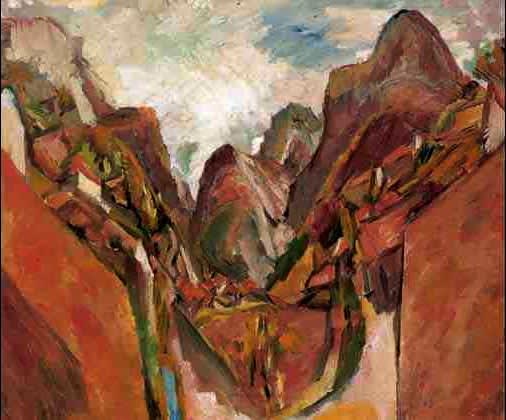David Bomberg 1890-1957
Picos de Europa, Asturias, 1935
Oil on canvas
58.5 x 76 cms
23 1/16 x 29 14/16 ins
23 1/16 x 29 14/16 ins
1241
Sold
In the painting Picos de Europa, Asturias, Bomberg uses a daring composition to enhance the drama. To the left and right, the mountains are flanked by great sheets of rock,...
In the painting Picos de Europa, Asturias, Bomberg uses a daring composition to enhance the drama. To the left and right, the mountains are flanked by great sheets of rock, which frame our view, leading our eyes deep into the picture, as though travelling through the rocky terrain. Houses cling to the hills, the colours sing and the density of the sky prevents any dissipation of energy.
In contrast, a related drawing has a more ethereal quality. There is a lightness to the handling of charcoal that stands in contrast to the darkness of the image. The result possesses a superficial kinship with the early drawings of Auerbach and Kossoff, but its expressive looseness is far removed from their densely reworked surfaces. The drawing feels as though it was completed rapidly and in a single go, and one senses that the darkness may have been actual, rather than the result of the choice of medium. This was a moment in Bomberg's career when he was working at night as well as during the day, by moonlight as well as sunlight and was capturing both the dark moments before a storm and the penetrating shafts of light that marked its ending. Yet, this is not to suggest that the mood of these works merely reflects the elements, for there is surely an emotional aspect that anticipates the pictures that Bomberg made in the last years of his life, when he had again settled in Spain. In both painting and drawing, the mountain, like the man, is a brooding presence, inviolate in the face of hostile forces.
In contrast, a related drawing has a more ethereal quality. There is a lightness to the handling of charcoal that stands in contrast to the darkness of the image. The result possesses a superficial kinship with the early drawings of Auerbach and Kossoff, but its expressive looseness is far removed from their densely reworked surfaces. The drawing feels as though it was completed rapidly and in a single go, and one senses that the darkness may have been actual, rather than the result of the choice of medium. This was a moment in Bomberg's career when he was working at night as well as during the day, by moonlight as well as sunlight and was capturing both the dark moments before a storm and the penetrating shafts of light that marked its ending. Yet, this is not to suggest that the mood of these works merely reflects the elements, for there is surely an emotional aspect that anticipates the pictures that Bomberg made in the last years of his life, when he had again settled in Spain. In both painting and drawing, the mountain, like the man, is a brooding presence, inviolate in the face of hostile forces.




